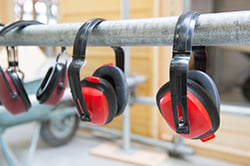 According to the National Institute for Occupational Safety and Health (NIOSH), about 30 million workers in the U.S. are exposed to hazardous noise. One of the most common occupational diseases is noise-induced hearing loss. With this many workers at risk each day, it also means very high risks of workers’ comp claims, which can be very costly to companies. What can be done? How can you protect your workers against hearing loss?
According to the National Institute for Occupational Safety and Health (NIOSH), about 30 million workers in the U.S. are exposed to hazardous noise. One of the most common occupational diseases is noise-induced hearing loss. With this many workers at risk each day, it also means very high risks of workers’ comp claims, which can be very costly to companies. What can be done? How can you protect your workers against hearing loss?
The First Line Of Defense: Noise Control
Noise controls can be used to protect workers from hazardous noise exposure. These controls help to reduce or even eliminate excessive exposure. Even small reductions in decibels can make a significant positive impact on hearing conservation.
Engineering controls isolate people from the noise hazard. Equipment is modified or replaced, or physical changes are made to the noise source or its path of transmission in order to reduce the level of noise at the employee’s ear. OSHA provides several examples of engineering controls that can significantly protect workers from noise:
- Choose low-noise tools and machinery
- Maintain and lubricate machinery and equipment
- Place a barrier between the noise source and employee
- Enclose or isolate the noise source
Administrative controls are changes in the way people work. The workplace is changed to reduce or eliminate the noise exposure. Examples from OSHA include:
- Operating noisy machines during shifts when fewer people are exposed
- Limiting the amount of time a person spends at a noise source
- Providing quiet areas where workers can gain relief from hazardous noise sources
- Restricting worker presence to a suitable distance away from noisy equipment
Hearing Protection Devices
When exposure to hazardous noise is unavoidable, hearing protection devices (HPDs) should be used. Implementing engineering or administrative controls are more desirable solutions, but sometimes these controls are not feasible. Noise control solutions are not immediate, so HPDs should also be utilized while you are working to implement your engineering and administrative controls.
The three basic types of HPDs are: ear muffs, ear plugs, and canal caps. Each HPD is assigned a Noise Reduction Rating. This number is an estimate of the reduction of noise provided by the device.
Hearing Conservation Programs
Hearing conservation programs are designed to prevent the initial occupational hearing loss, preserve and protect employees’ remaining hearing, and provide workers with proper knowledge, training and HPDs to protect them from hazardous noise exposure.
OSHA defines the key elements of an effective hearing conservation program as:
- Workplace noise sampling including personal noise monitoring which identifies which employees are at risk from hazardous levels of noise.
- Informing workers at risk from hazardous levels of noise exposure of the results of their noise monitoring.
- Providing affected workers or their authorized representatives with an opportunity to observe any noise measurements conducted.
- Maintaining a worker audiometric testing program (hearing tests) which is a professional evaluation of the health effects of noise upon individual worker's hearing.
- Implementing comprehensive hearing protection follow-up procedures for workers who show a loss of hearing (standard threshold shift) after completing baseline (first) and yearly audiometric testing.
- Proper selection of hearing protection based upon individual fit and manufacturer's quality testing indicating the likely protection that they will provide to a properly trained wearer.
- Evaluate the hearing protectors attenuation and effectiveness for the specific workplace noise.
- Training and information that ensures the workers are aware of the hazard from excessive noise exposures and how to properly use the protective equipment that has been provided.
- Data management of and worker access to records regarding monitoring and noise sampling.
For additional resources about noise exposure, noise controls, and hearing conservation programs, visit:



